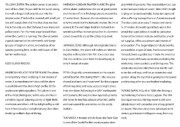Page 488 - Melanesia
P. 488
YELLOW CENTER: The yellow corner is an exten- AMERICAN CORSAIR FIGHTER PLANE: The pilot able WWII shipwrecks. This reasonably intact Jap-
sion of Naru Wall. As you drift to the south along of this plane crashed into the sea at great speed anese transport ship of some 140m (450’) length
the wall, a large knoll extends out into the and the aircraft is in five large pieces around the is lying on its starboard site. It was run aground
deeper water. This knoll is covered with small yel- 27 meter level. However the attraction is not after suffering damage from an American attack.
low soft corals. Out of all the dive sites we dive, only the wreck but the fantastic marine life on or The dive starts at an easy 7 meters and slants
this is the only one that features these iridescent around it. The reef slope back to the boat is in- to 37 meters. Interesting artefacts adorn this
yellow corals. For the more experienced diver, teresting and has its own attraction in a bommie vessel that sunk before it could be unloaded.
when the current is running. This dive provides called clown fish city at the safety stop level. Some of the trinkets include saki bottles, medi-
a good contrast to the other reefs, with large cal supplies, office equipment and rounds of
groups of staghorn corals, and various other JAPANESE ZERO: Although not originally found ammunition. The larger objects include bombs,
species growing here, as this reef is part of the in Gizo Harbor, the plane still makes an interest- a motorbike, a type 21 tank. For the more expe-
barrier reef to Gizo. ing dive with resident lion fish. On a clear day rienced divers a guided tour inside the wreck to
this can easily be seen from the boat laying in many rooms still easily accessible, including the
GIZO ISLAND WRECKS only 9 meters of water. work shop, crew quarters, and dining area. The
wreck also receives visits from marine life such
AMERICAN HELLCAT FIGHTER PLANE: The plane PETAJ: Originally commissioned as the coastal as turtles and rays, and has an extensive coral
is completely intact and lying in ten meters of patrol boat ML 805 during WW11. She was pur- garden along the top that is great place to spend
water. A comprehensive history of the plane chased and sunk as a ‘house reef’ for the purpose a safety stop after you are finished exploring.
is available and the dive is high on the list for of training dives and easy access to night dives
underwater photographers. This plane is one from the shore. Following the 2007 earthquake TOYOKO MARU II: Sunk in 1988 after hitting a
of the most photogenic in the area, and lies in and tsunami, the wreck is now opened up but is reef entering the Vona Vona Lagoon. This 100
a shallow lagoon allowing plenty of light. Both still home to lion fish, schools of batfish, puffer foot Japanese tuna fishing vessel is still com-
snorkelers and divers will be delighted by a visit and surrounded by anenomes on the sandy pletely intact with propeller and all equipment
here. This is usually a complimentary dive when bottom. on board. The dive site is more advanced at 45
booking multiple days of diving. meters, positioned mid lagoon away from any
TOA MARU: A twenty minute boat ride from Gizo reefs.
is one of the South Pacific’s most popular dive-

